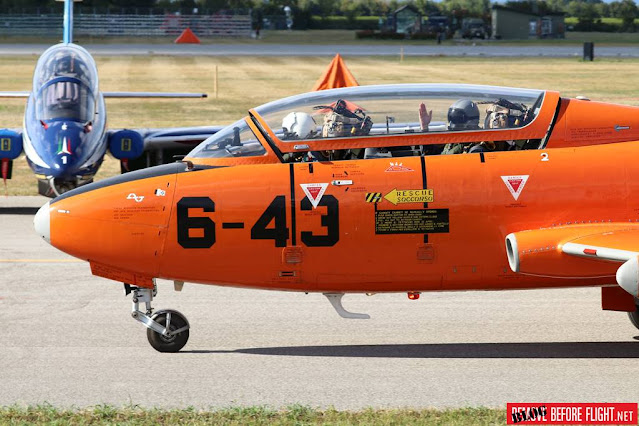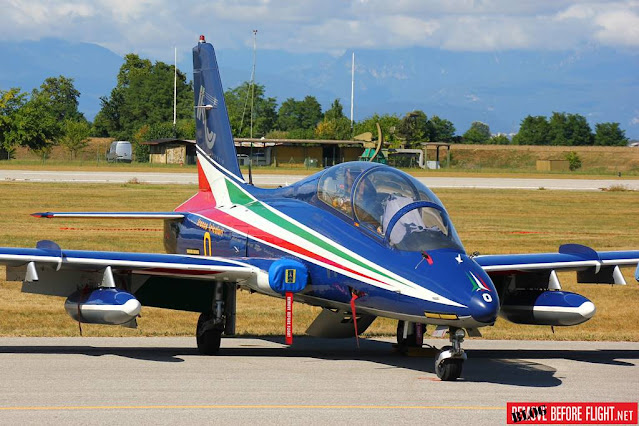Aermacchi MB-339 trainer jet: an all-Italian success story
 |
| Italian Air Force MB-339A trainer jet assigned to 61st Wing/Galatina AFB, Italy. |
The Aermacchi MB-339 cannot be missing from the list of aircraft that have made the history of the Italian aerospace industry. Thanks to the iconic jet, known all over the world as the aircraft of the ITAF Frecce Tricolori demo team, Aermacchi (now Leonardo SpA) has consolidated a prominent position in the national and international market of trainer aircraft.
The climb to the top of the firm began with the extraordinary success of the MB-326. The jet flew for the first time in December 1957 and was then delivered to the operational departments of the Italian Air Force starting in 1961. The MB-326 was revolutionary in that it offered military flight schools a simple, robust and suitable jet to cover the whole training process for jet pilots: from the elementary to the advanced phase.
The aircraft was popular with a number of air forces, more than 800 platforms were made. That success allowed the "small" Aermacchi to become a world leader in the sector and represented a very exciting page of history for Italy's technical and industrial capabilities. The aircraft has trained thousands of pilots around the world, as well as generations of skilled engineers in Italy, Brazil, South Africa and Australia (where the MB-326 was manufactured under license), who have built a hard core of capability to benefit of the entire aeronautical sector.
The climb to the top of the firm began with the extraordinary success of the MB-326. The jet flew for the first time in December 1957 and was then delivered to the operational departments of the Italian Air Force starting in 1961. The MB-326 was revolutionary in that it offered military flight schools a simple, robust and suitable jet to cover the whole training process for jet pilots: from the elementary to the advanced phase.
The aircraft was popular with a number of air forces, more than 800 platforms were made. That success allowed the "small" Aermacchi to become a world leader in the sector and represented a very exciting page of history for Italy's technical and industrial capabilities. The aircraft has trained thousands of pilots around the world, as well as generations of skilled engineers in Italy, Brazil, South Africa and Australia (where the MB-326 was manufactured under license), who have built a hard core of capability to benefit of the entire aeronautical sector.
European competitors responded to the success of the Italian-made jet with products such as the British Hawk and the Franco-German Alpha Jet. Aermacchi, however, immediately worked hard to maintain its market leadership. At the beginning of the 1970s, the Italian Air Force began to define the operational requirement for the replacement of the MB-326.
At the time, Aermacchi was in competition with FIAT, which offered its G-91YT, a two-seater variant of the G-91Y, as an advanced trainer. The final choice of service was in favor of the MB-339. The MB-339 was developed on the basis of the MB-326, but with a new engine, nose, cockpit, wings and tailplanes. The project had all it takes to be successful.
From an industrial point of view, the aircraft was easy to build and required traditional construction processes. It was well suited for eventual licensed production in those markets that had already favored the MB-326. The company also aimed to obtain with the MB-339 the excellent results achieved by the MB-326 as a light attack aircraft. Compared to the "326", the "339" boasted better reliability and load capacity. The aircraft was robust, easy to maintain and operate, and offered excellent agility. These characteristics were later also appreciated by the Frecce Tricolori, whose image today is linked to that of the "339".
The relationship between the Frecce Tricolori and the aircraft began with some hesitation due to the straight wing, which compared to the swept wing of its predecessor, the G-91, does not forgive errors in maneuvers. However, over time this perfectionism imposed by the aircraft has become a "trademark" of the Frecce Tricolori and has contributed to making the aerobatic pilots of the Italian Air Force very popular all over the world.
At the time, Aermacchi was in competition with FIAT, which offered its G-91YT, a two-seater variant of the G-91Y, as an advanced trainer. The final choice of service was in favor of the MB-339. The MB-339 was developed on the basis of the MB-326, but with a new engine, nose, cockpit, wings and tailplanes. The project had all it takes to be successful.
From an industrial point of view, the aircraft was easy to build and required traditional construction processes. It was well suited for eventual licensed production in those markets that had already favored the MB-326. The company also aimed to obtain with the MB-339 the excellent results achieved by the MB-326 as a light attack aircraft. Compared to the "326", the "339" boasted better reliability and load capacity. The aircraft was robust, easy to maintain and operate, and offered excellent agility. These characteristics were later also appreciated by the Frecce Tricolori, whose image today is linked to that of the "339".
The relationship between the Frecce Tricolori and the aircraft began with some hesitation due to the straight wing, which compared to the swept wing of its predecessor, the G-91, does not forgive errors in maneuvers. However, over time this perfectionism imposed by the aircraft has become a "trademark" of the Frecce Tricolori and has contributed to making the aerobatic pilots of the Italian Air Force very popular all over the world.
From an operational point of view, the MB-339 allowed the armed forces to have a jet suitable for the entire training process, from basic to advanced, without having to multiply flight lines. Furthermore, the standard version could also be used as an LCA (Light Combat Aircraft). The MB-339 has thus proved to have a design and capabilities that make it effective in all contexts. In addition to Italy, it was introduced by Argentina, Peru, Malaysia, New Zealand, Nigeria, United Arab Emirates, Eritrea and Ghana.
As a trainer, the "339" was also among the finalists of the US Joint Primary Aircraft Training System program which was won by the T-6 Texan II. At the time, the American specifications were oriented towards basic training aircraft, therefore of much more modest performance. However, this defeat witnessed the inevitable and progressive aging of the formula adopted for the aircraft.
For this reason, between the 1990s and early 2000s, Aermacchi developed the updated variant of the aircraft, the MB-339CD, which boasts more modern cockpits and avionics. All the variants of the MB-339, A - CD - PAN, are still operational in the Italian Air Force fleet, they will soon be replaced by the modern Leonardo M-345.
As a trainer, the "339" was also among the finalists of the US Joint Primary Aircraft Training System program which was won by the T-6 Texan II. At the time, the American specifications were oriented towards basic training aircraft, therefore of much more modest performance. However, this defeat witnessed the inevitable and progressive aging of the formula adopted for the aircraft.
For this reason, between the 1990s and early 2000s, Aermacchi developed the updated variant of the aircraft, the MB-339CD, which boasts more modern cockpits and avionics. All the variants of the MB-339, A - CD - PAN, are still operational in the Italian Air Force fleet, they will soon be replaced by the modern Leonardo M-345.
Written by Matteo Sanzani
Source: Leonardo








No comments
All comments related to the contents of our articles are welcome. It is not allowed to post promotional messages, links to external sites, or references to activities not related to this blog.